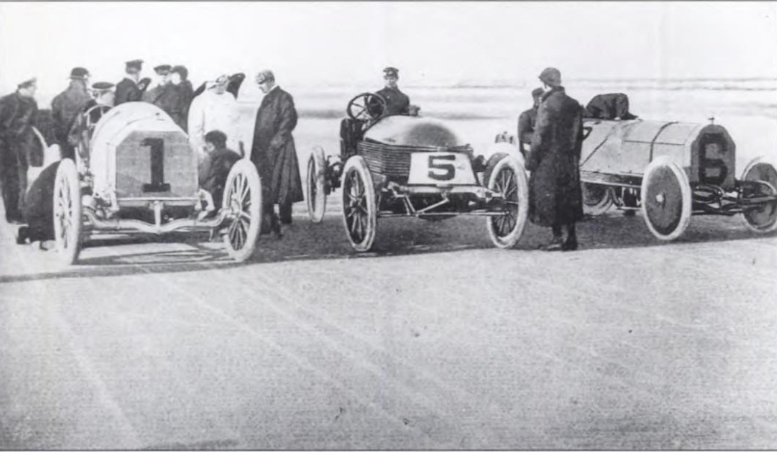The amount of engineering, time, and funding put into the racecars we know today is incredible. The National Association for Stock Car Auto Racing (NASCAR) is a multi-million dollar organization. Born from the Daytona Beach land speed competitions in the 1920s, NASCAR has become the brand for auto-racing sports in America. However, the association would not be where it is today without the invention of an automotive vehicle and a car race.
The First Car
We usually credit Henry Ford with the invention of the car due his success in making the automobile accessible to the masses. However, two brothers from Springfield, Massachusetts created the first car in 1893, 15 years before Ford made the Model T. The Duryea brothers are known for being early pioneers of the U.S. auto industry. Their company, Duryea Motor Wagon Company, was the first to manufacture gasoline-powered automobiles.
The name Motor Wagon was derived from their first creation. They purchased a $70 horse buggy into which they installed a 4-horsepower, single-cylinder engine. The first model was donated to the United States National Museum by one of the brother’s granddaughters in the 1920s.
Their company was successful until the beginning of the 20th century. The brothers had parted ways due to disagreements in financing, and the luxury vehicles they produced could not compete with Ford’s more affordable automobile. However, their rise to fame and contribution to the history of American automobiles all began with a race.
The Race
In June 1895, the Chicago Times-Herald announced that the publication would hold a “Moto-Cycle” race for automobile makers. Auto engineering was wildly popular and advanced internationally. The race was meant to ignite growth in the U.S. auto industry. Anyone was welcome to enter his vehicle in the race, including competitors from abroad. There was a grand prize of $5,000 ($142,000 today), and all the bragging rights the title entailed.
The race was first scheduled for early November. Though there were over 80 entrants, only a handful ended up arriving. Many of the entrants were unable to complete their vehicles in time, while others were unable to make the journey due to the nature of the roads at that time. Because of this, the Herald postponed the date of the race to Thanksgiving Day.

It had snowed the day before the race, which caused the roads to be muddy and created snowdrifts. This did not stop the six competitors from starting up their vehicles. Among them were the Duryea Brothers with the first American four-wheeled gas-powered car, three (four-wheeled) Benz cars, and two (two-wheeled) vehicles. Of the last two, one was electric-powered. However, once the race began, the battery of the electric vehicle eventually died, and the other motorcycle did not have enough power to make the steep climbs on the course.
The Benz cars kept the lead until the return trip. One had collided with a horse and was forced to forfeit. Only three vehicles remained, including the Duryeas’ motor wagon. The Duryeas took the lead and won 1st place after completing the 54-mile course in 7 hours and 53 minutes. A Benz crossed the finish line an hour and a half later, taking second place. None of the other vehicles completed the race. The result was unprecedented. Though only traveling at 7.5 mph, the Duryea Motor Wagon was the first American car to beat an international competitor.
The news of the race became a national headline. Many claimed that the age of horse-dependent transportation was over, due to the vehicles’ abilities to run in extreme weather. The Herald was successful in their attempt to ignite the auto industry. Only a year later, in 1894, commercial production of cars began in the U.S.
Car Racing Since
Following the Chicago Times-Herald race, there were not any formal competitions in the U.S. In places like France and Belgium, vehicles competed in timed land-speed competitions. This trend eventually made its way to Daytona Beach, Florida. However, races where cars competed alongside each other were born from the bootlegging days of Prohibition.
Bootleggers in the Appalachian region used small vehicles to quickly transport whiskey and hooch across county lines and evade law enforcement. The bootleggers started modifying their vehicles for faster speed, better handling, and, of course, increased cargo space. After Prohibition was repealed and the bootleggers’ businesses rendered legal, the former outlaws continued speeding through Appalachia, except this time to escape tax collectors. The fast cars hurrying down the dirt roads became a staple in Appalachia and Southern culture that would last through the decades.
By the late 1940s, car-racing enthusiasts no longer had to watch from afar. Car races were held in public and for profit. People could come watch as drivers pulled up with their modified cars and raced for first place. After a significant car race in Daytona Beach, NASCAR founder Bill France realized there was a venture to be had in the sport of auto-racing.

